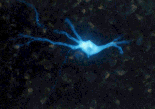| Sponsored by Wake Forest University School of Medicine and National Families in Action | ||||
| Glossary - B | ||||
| This glossary comes from False Messengers: How Addictive Drugs Change the Brain, by David Friedman, PhD, and Sue Rusche, Harwood Academic Publishers, Amsterdam, The Netherlands, 1999. A
| B | C | D
| E | F
| G | H
| I |
|
||||
| B Barbiturates Depressant drugs that produce relaxation and sleep. Barbiturates include sleeping pills such as pentobarbital (Nembutal) and secobarbital (Seconal). Basal ganglia The large, complex set of brain structures involved in generating movements, in some cognitive functions, and in some emotional and motivational activities. The basal ganglia and the cerebral cortex work together to refine movements, thoughts, and feelings. Behavior The observable activity of humans and animals. Behaviorism The study of behavior, especially using operant conditioning. Benzodiazepines The so-called "minor" tranquilizers, depressants, which relieve anxiety and produce sleep. Benzodiazepines include tranquilizers such as diazepam (Valium) and alprazolam (Xanax) and sleeping pills such as flurazepam (Dalmane) and triazolam (Halcion). Bernard, Claude The physiologist who coined the term "homeostasis." Bind What occurs when a neurotransmitter attaches itself to a receptor. The neurotransmitter is said to "bind" to the receptor.
|
|
Binge Uninterrupted consumption of a drug for several hours or days. Bolus A concentrated amount of drug; a dose injected rapidly into a vein, a rounded mass of matter. Brain The part of the central nervous system inside our heads. Our brain is the seat of all our perceptions, thoughts, feelings and voluntary movements. Brain reward system A brain circuit that, when activated, reinforces behaviors. The circuit includes the dopamine-containing neurons of the ventral tegmental area, the nucleus accumbens, and part of the prefrontal cortex. We perceive the activation of this circuit as pleasure. Brain stem The relatively primitive brain structure that starts where our spinal cord enters our head. Neurons within the brain stem control basic functions such as heart rate and breathing. Broca, Paul The scientist who identified the area in the brain responsible for producing speech, now called Broca's area. Buprenorphine A long-lasting opiate analgesic that has both opiate agonist and antagonist properties. Buprenorphine shows promise for treating heroin addiction. |
||
| Home | For Journalists | For the States | Science Update | Links | Glossary | About |
Last Revision
info@addictionstudies.org

